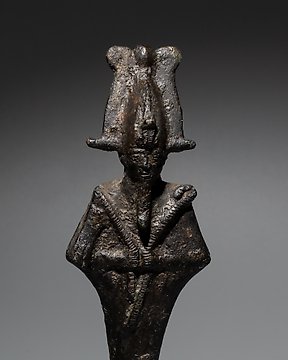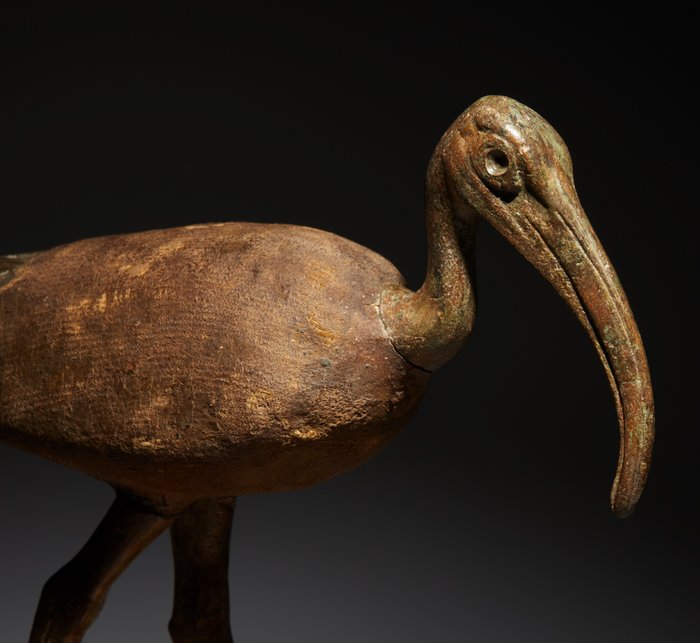
Altägyptisch Bronze Gott Osiris. Spätzeit, 664 - 323 v. Chr. 11,5 cm H.
Nr. 83493127

Nr. 83493127

Ibis.
- Important Piece -
Ancient Egypt, Late Period, 664 - 332 BC.
Wood, linen and bronze.
16.3 cm height, 19.5 cm length. witout stand.
CONDITION: Good condition, without restorations.
PROVENANCE:
- Private collection, P.S., Switzerland, born in 1946.
- Art market, Switzerland, 2005.
- David Ghezelbash, Paris.
DOCUMENTS: Provided of a certificate of authenticity and export license by the Ministry of Culture from Spain.
DESCRIPTION:
A statuette depicting a sacred ibis in a marching stance, striding forward in search of food in the shallow waters of the Nile. The animal, with its wings folded against its body, advances its left leg and keeps its head slightly inclined downwards, with its beak closed. The sculpture combines two materials: carved wood for the body and lost-wax cast bronze, with cold-incised details, for the head, legs and tail. The wood is covered with a layer of linen, hardened and finally polychromed. The combination of different materials was widely used in Egyptian statuary and, within votive statuettes, mainly for the representation of the ibis (fig. 1). Ibis statuettes of this type have been found in catacombs together with mummies of the same animal, as well as in deposits linked to temples and sanctuaries.
In this piece the modelling acquires a special naturalism in the bronze parts, where descriptive details such as the texture of the legs or the tail feathers can be seen. The excavated eyes indicate that, originally, they would have housed inclusions of other material, which would enhance the liveliness and attractiveness of the image (fig. 2). Both the volumes and the delicate and elegant movement, and especially the details of the bronze parts, reflect with their realism the mastery of a sculptor who has been able to combine the observation of nature with the abstraction of the image of a sacred animal.
The Threskiornis aethiopicus or sacred ibis is distinguished by its flexible and graceful neck, which it holds stretched forward when flying, by its long curved beak and by its white plumage, which contrasts with the black of its tail, neck and head; hence the use of two materials in the statuettes representing it, which in most cases have a body of marble or white-painted wood (fig. 3). This bird is able to distinguish between clean and dirty water, which was proof of its immense wisdom in the eyes of the Egyptians, who honoured it to the point of making it one of the incarnations of the god Thoth (fig. 4). In fact, some of the ibis statuettes were actually sarcophagi for ibis mummies, which were presented as offerings in the chapels dedicated to Thoth.
The Egyptian god Dyeuthy, popularised under his Greek name, Thoth, was the god of wisdom and magic, of writing, science and the arts. He had authority over all other gods, and was the inventor of hieroglyphic writing and articulate language itself. He was associated mainly with the ibis but also with the baboon; he is often depicted as a man with the head of an ibis, or in the full form of a baboon. Thoth is also the inventor of the calendar, and was responsible for writing the royal annals on the fruits of the persea, the sacred tree of Heliopolis. Also linked to the world of the dead, he was present at the psychostasis or weighing of the soul of the deceased, being in charge of writing down the verdict of the judgement of Osiris. He was also considered to be the supreme architect, knowing the paths and trajectories of all things, and therefore lord of inventors and science.
The spectacular black and white plumage of the ibis led some classical authors, such as Plutarch and Elian, to explain the Egyptians' assimilation of the animal with the moon, based on a parallelism with the moon's phases of illumination and disappearance. This symbolic aspect of the ibis is linked to Thoth's function as guardian and protector of the lunar cycle. In fact, it was the behaviour of this wading bird that underpinned the theology linked to the god Thoth; among other features, its wandering through the vegetation of the marshes gave rise to the cult of the god 'Thoth who is perched in his thicket', while the powerful and sharp beak made it associated with the writing instrument emblematic of the god of the scribes, but also with the fight against the serpent Apophis, the incarnation of evil. In his funerary aspect, Thoth is found in the room where the soul is weighed on a scale (psychostasis) where, before Osiris, the heart of the deceased was judged. His function was that of a scribe, as he had to write down the verdict of the lord of the underworld. Thoth was also considered the architect who knew the paths and trajectories of all things, the lord of inventors and wisdom, and was connected with music as the inventor of the lyre.
BIBLIOGRAPHY:
- BLEIBERG, E. Soulful Creatures. Animal Mummies in Ancient Egypt. Brooklyn Museum. 2013.
- CASTEL, E. Gran Diccionario de Mitología Egipcia. Aldebarán. 2001.
- GUICHARD, H. et al. Animales y Faraones. El Reino Animal en el Antiguo Egipto. Catálogo de exposición. Obra Social La Caixa, Barcelona. 2015.
- WILKINSON, R.H. The Complete Gods and Goddesses of Ancient Egypt. Thames and Hudson. 2003.
PARALLELS:
Fig. 1 Ibis. Egypt, Late Antique or Ptolemaic Period, ca. 664-30 BC. Wood, bronze and wax inlay; 19.7 cm high. Detroit Institute of Arts (USA), inv. 76.7.
Fig. 2 Ibis. Egypt, Late Antique, ca. 664-332 BC. Wood, bronze, jasper and gold leaf; 44 cm high. Pelizaeus-Museum, Hildesheim (Germany), inv. 4749.
Fig. 3 Ibis. Egypt, Late Egyptian or Ptolemaic Period, ca. 664-30 BC. Wood and bronze, 41.91 cm high. Nelson-Atkins Museum of Art, Kansas City (USA), inv. 58-4.
Fig. 4 Thot as an ibis. Egypt, Late Antiquity, 6th century BC. Stuccoed wood, silver and glass; 28.8 cm high. Kunsthistorisches Museum Wien, inv. 10073.
Notes:
- The piece includes authenticity certificate.
- The piece includes Spanish Export License.
- The seller guarantees that he acquired this piece according to all national and international laws related to the ownership of cultural property. Provenance statement seen by Catawiki.
#ancientcivilisations
So kaufen Sie auf Catawiki
1. Etwas Besonderes entdecken
2. Höchstgebot abgeben
3. Sichere Zahlung durchführen